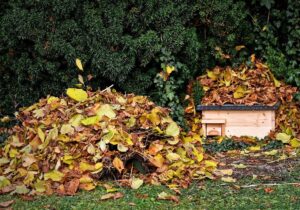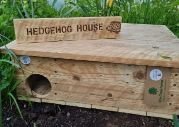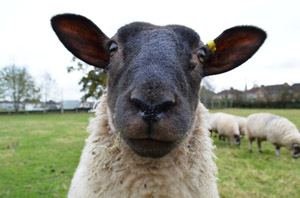October is the time of year when we start thinking about seasonal festivities and putting the garden to bed for the winter. But, before you go lighting the bonfire and mucking the winter beds, spare a thought for one of the nation’s favourite garden visitors, the hedgehog.
Look after your garden visitors
 We have a few tips to make sure that you can enjoy your harvest festivities and carry out season garden chores, in harmony with this prickly little beauty.
We have a few tips to make sure that you can enjoy your harvest festivities and carry out season garden chores, in harmony with this prickly little beauty.
Before forking over the compost heap or lighting the bonfire, we recommend gently checking around the heap. They are common hiding places for hedgehogs. Leaving some areas of wilderness in your garden for hedgehogs to snuffle for insects is a good idea too. The British Isles has seen numbers of hedgehogs plummet due to lack of habitat and use of chemicals. Please think before you use pesticides or slug pellets, at any time of the year.
Help our urban hedgehogs
In the wild, hedgehogs spend the autumn gathering leaves, grass, straw, bracken, reeds and so on, to build a nest for winter hibernation. They are incredibly good at this and are able to create very warm, dry nests to shelter from the rain and cold.
 For urban hedgehogs however, finding the building materials and a hedgerow to nest under is more of a challenge. You could find a quiet part of your garden to place a hedgehog house, and cover it with leaves and foliage. This will provide a safe haven for these much-loved and endangered creatures.
For urban hedgehogs however, finding the building materials and a hedgerow to nest under is more of a challenge. You could find a quiet part of your garden to place a hedgehog house, and cover it with leaves and foliage. This will provide a safe haven for these much-loved and endangered creatures.
Autumn and early winter is also an essential time to feed hedgehogs in your garden. They need to reach a safe hibernation weight before late December, so now is a good time to start thinking about giving a helping hand.
What to feed hedgehogs
Hedgehogs need to reach 600 grams by late autumn to have enough fat reserves to survive hibernation. If they don’t make this weight, they might not make it through the winter.
 Put out a bowl of meaty dog or cat food around dusk, with some mealworm (which they absolutely love as a treat). Hedgehogs don’t eat and sleep in the same place, so if you notice you have a new resident, move the food a little further away from their new nest or house.
Put out a bowl of meaty dog or cat food around dusk, with some mealworm (which they absolutely love as a treat). Hedgehogs don’t eat and sleep in the same place, so if you notice you have a new resident, move the food a little further away from their new nest or house.
We would never advise you to pick up a hedgehog under normal circumstances, but if you find a injured hedgehog or a youngster that is too small to hibernate, wear thick garden gloves and scoop it up with both hands. A hot water bottle and a tea towel to hide under, in a newspaper-lined cardboard box is all you need to transport to a rescue centre. If you do have to keep the hedgehog overnight, don’t forget to give it a bowl of water and some food.
Get a hedgehog house from Splinters
 We hope this has given you some helpful information. If you’re looking to buy your own hedgehog house, you can pop into our farm shop and pick up a handmade house made by our very own Splinters workshop.
We hope this has given you some helpful information. If you’re looking to buy your own hedgehog house, you can pop into our farm shop and pick up a handmade house made by our very own Splinters workshop.
To try to encourage and protect hedgehogs in the local area, Emerson’s Green Town Council have already purchased 25 of these lovely homes, made from recycled wood, which they have distributed them to local residents for their gardens. So why not grab one for yourself and do your bit to protect the UK’s favourite spiky little mammal.


